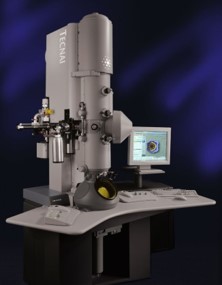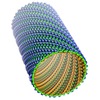+ データを開く
データを開く
- 基本情報
基本情報
| 登録情報 | データベース: EMDB / ID: EMD-5341 | |||||||||
|---|---|---|---|---|---|---|---|---|---|---|
| タイトル | Chemically controlled assembly of 1, 2 and 3-dimensional protein arrays | |||||||||
 マップデータ マップデータ | This is a surface rendered side-view of an engineered RIDC3 nanotube | |||||||||
 試料 試料 |
| |||||||||
 キーワード キーワード | nanotube / self assembly / protein array / ridc3 / metal coordination | |||||||||
| 機能・相同性 | Cytochrome b562 / Cytochrome b562 / Cytochrome c/b562 / electron transport chain / periplasmic space / electron transfer activity / iron ion binding / heme binding / Soluble cytochrome b562 機能・相同性情報 機能・相同性情報 | |||||||||
| 生物種 |  | |||||||||
| 手法 | らせん対称体再構成法 / クライオ電子顕微鏡法 / 解像度: 10.0 Å | |||||||||
 データ登録者 データ登録者 | Brodin JD / Ambroggio XI / Tang C / Parent KN / Baker TS / Tezcan FA | |||||||||
 引用 引用 |  ジャーナル: Nat Chem / 年: 2012 ジャーナル: Nat Chem / 年: 2012タイトル: Metal-directed, chemically tunable assembly of one-, two- and three-dimensional crystalline protein arrays. 著者: Jeffrey D Brodin / X I Ambroggio / Chunyan Tang / Kristin N Parent / Timothy S Baker / F Akif Tezcan /  要旨: Proteins represent the most sophisticated building blocks available to an organism and to the laboratory chemist. Yet, in contrast to nearly all other types of molecular building blocks, the designed ...Proteins represent the most sophisticated building blocks available to an organism and to the laboratory chemist. Yet, in contrast to nearly all other types of molecular building blocks, the designed self-assembly of proteins has largely been inaccessible because of the chemical and structural heterogeneity of protein surfaces. To circumvent the challenge of programming extensive non-covalent interactions to control protein self-assembly, we have previously exploited the directionality and strength of metal coordination interactions to guide the formation of closed, homoligomeric protein assemblies. Here, we extend this strategy to the generation of periodic protein arrays. We show that a monomeric protein with properly oriented coordination motifs on its surface can arrange, on metal binding, into one-dimensional nanotubes and two- or three-dimensional crystalline arrays with dimensions that collectively span nearly the entire nano- and micrometre scale. The assembly of these arrays is tuned predictably by external stimuli, such as metal concentration and pH. | |||||||||
| 履歴 |
|
- 構造の表示
構造の表示
| ムービー |
 ムービービューア ムービービューア |
|---|---|
| 構造ビューア | EMマップ:  SurfView SurfView Molmil Molmil Jmol/JSmol Jmol/JSmol |
| 添付画像 |
- ダウンロードとリンク
ダウンロードとリンク
-EMDBアーカイブ
| マップデータ |  emd_5341.map.gz emd_5341.map.gz | 57.9 MB |  EMDBマップデータ形式 EMDBマップデータ形式 | |
|---|---|---|---|---|
| ヘッダ (付随情報) |  emd-5341-v30.xml emd-5341-v30.xml emd-5341.xml emd-5341.xml | 10 KB 10 KB | 表示 表示 |  EMDBヘッダ EMDBヘッダ |
| 画像 |  emd_5341_1.png emd_5341_1.png | 477.2 KB | ||
| アーカイブディレクトリ |  http://ftp.pdbj.org/pub/emdb/structures/EMD-5341 http://ftp.pdbj.org/pub/emdb/structures/EMD-5341 ftp://ftp.pdbj.org/pub/emdb/structures/EMD-5341 ftp://ftp.pdbj.org/pub/emdb/structures/EMD-5341 | HTTPS FTP |
-検証レポート
| 文書・要旨 |  emd_5341_validation.pdf.gz emd_5341_validation.pdf.gz | 78.9 KB | 表示 |  EMDB検証レポート EMDB検証レポート |
|---|---|---|---|---|
| 文書・詳細版 |  emd_5341_full_validation.pdf.gz emd_5341_full_validation.pdf.gz | 78 KB | 表示 | |
| XML形式データ |  emd_5341_validation.xml.gz emd_5341_validation.xml.gz | 493 B | 表示 | |
| アーカイブディレクトリ |  https://ftp.pdbj.org/pub/emdb/validation_reports/EMD-5341 https://ftp.pdbj.org/pub/emdb/validation_reports/EMD-5341 ftp://ftp.pdbj.org/pub/emdb/validation_reports/EMD-5341 ftp://ftp.pdbj.org/pub/emdb/validation_reports/EMD-5341 | HTTPS FTP |
-関連構造データ
- リンク
リンク
| EMDBのページ |  EMDB (EBI/PDBe) / EMDB (EBI/PDBe) /  EMDataResource EMDataResource |
|---|---|
| 「今月の分子」の関連する項目 |
- マップ
マップ
| ファイル |  ダウンロード / ファイル: emd_5341.map.gz / 形式: CCP4 / 大きさ: 238.4 MB / タイプ: IMAGE STORED AS FLOATING POINT NUMBER (4 BYTES) ダウンロード / ファイル: emd_5341.map.gz / 形式: CCP4 / 大きさ: 238.4 MB / タイプ: IMAGE STORED AS FLOATING POINT NUMBER (4 BYTES) | ||||||||||||||||||||||||||||||||||||||||||||||||||||||||||||||||||||
|---|---|---|---|---|---|---|---|---|---|---|---|---|---|---|---|---|---|---|---|---|---|---|---|---|---|---|---|---|---|---|---|---|---|---|---|---|---|---|---|---|---|---|---|---|---|---|---|---|---|---|---|---|---|---|---|---|---|---|---|---|---|---|---|---|---|---|---|---|---|
| 注釈 | This is a surface rendered side-view of an engineered RIDC3 nanotube | ||||||||||||||||||||||||||||||||||||||||||||||||||||||||||||||||||||
| 投影像・断面図 | 画像のコントロール
画像は Spider により作成 | ||||||||||||||||||||||||||||||||||||||||||||||||||||||||||||||||||||
| ボクセルのサイズ | X=Y=Z: 2.88 Å | ||||||||||||||||||||||||||||||||||||||||||||||||||||||||||||||||||||
| 密度 |
| ||||||||||||||||||||||||||||||||||||||||||||||||||||||||||||||||||||
| 対称性 | 空間群: 1 | ||||||||||||||||||||||||||||||||||||||||||||||||||||||||||||||||||||
| 詳細 | EMDB XML:
CCP4マップ ヘッダ情報:
| ||||||||||||||||||||||||||||||||||||||||||||||||||||||||||||||||||||
-添付データ
- 試料の構成要素
試料の構成要素
-全体 : an engineered cytochrome cb562, RIDC3
| 全体 | 名称: an engineered cytochrome cb562, RIDC3 |
|---|---|
| 要素 |
|
-超分子 #1000: an engineered cytochrome cb562, RIDC3
| 超分子 | 名称: an engineered cytochrome cb562, RIDC3 / タイプ: sample / ID: 1000 / 集合状態: The asymmetric unit is a tetramer / Number unique components: 1 |
|---|---|
| 分子量 | 実験値: 124 KDa / 手法: MALDI |
-分子 #1: cytochrome cb562 variant
| 分子 | 名称: cytochrome cb562 variant / タイプ: protein_or_peptide / ID: 1 / Name.synonym: ridc3 / 集合状態: dimer / 組換発現: Yes |
|---|---|
| 由来(天然) | 生物種:  |
| 分子量 | 実験値: 124 KDa / 理論値: 124 KDa |
| 組換発現 | 生物種:  |
-実験情報
-構造解析
| 手法 | クライオ電子顕微鏡法 |
|---|---|
 解析 解析 | らせん対称体再構成法 |
| 試料の集合状態 | filament |
- 試料調製
試料調製
| 濃度 | 1.2 mg/mL |
|---|---|
| 緩衝液 | pH: 5.5 / 詳細: 20 mM MES, 10 mM ZnCl2 |
| グリッド | 詳細: home-made lacey carbon with a thin layer of continuous carbon |
| 凍結 | 凍結剤: ETHANE / チャンバー内湿度: 100 % / チャンバー内温度: 89 K / 装置: HOMEMADE PLUNGER / 詳細: Vitrification instrument: manual plunge-freezer / 手法: Blot for 5 seconds before freezing |
- 電子顕微鏡法
電子顕微鏡法
| 顕微鏡 | FEI POLARA 300 |
|---|---|
| 温度 | 最低: 90 K / 最高: 90 K / 平均: 90 K |
| アライメント法 | Legacy - 非点収差: at working magnification |
| 日付 | 2011年6月23日 |
| 撮影 | カテゴリ: CCD フィルム・検出器のモデル: GENERIC GATAN (4k x 4k) 平均電子線量: 15 e/Å2 |
| 電子線 | 加速電圧: 200 kV / 電子線源:  FIELD EMISSION GUN FIELD EMISSION GUN |
| 電子光学系 | 倍率(補正後): 52027 / 照射モード: FLOOD BEAM / 撮影モード: BRIGHT FIELD / Cs: 2.3 mm / 最大 デフォーカス(公称値): 3.675 µm / 最小 デフォーカス(公称値): 1.75 µm / 倍率(公称値): 39000 |
| 試料ステージ | 試料ホルダー: Polara Multi Specimen Holder / 試料ホルダーモデル: GATAN LIQUID NITROGEN |
| 実験機器 |  モデル: Tecnai Polara / 画像提供: FEI Company |
- 画像解析
画像解析
| 最終 再構成 | 想定した対称性 - らせんパラメータ - Δz: 25.7 Å 想定した対称性 - らせんパラメータ - ΔΦ: 5.3 ° 想定した対称性 - らせんパラメータ - 軸対称性: C9 (9回回転対称) アルゴリズム: OTHER / 解像度のタイプ: BY AUTHOR / 解像度: 10.0 Å / 解像度の算出法: OTHER / ソフトウェア - 名称: IHRSR |
|---|---|
| CTF補正 | 詳細: ROBEM and IHRSR |
 ムービー
ムービー コントローラー
コントローラー













 Z (Sec.)
Z (Sec.) Y (Row.)
Y (Row.) X (Col.)
X (Col.)





















